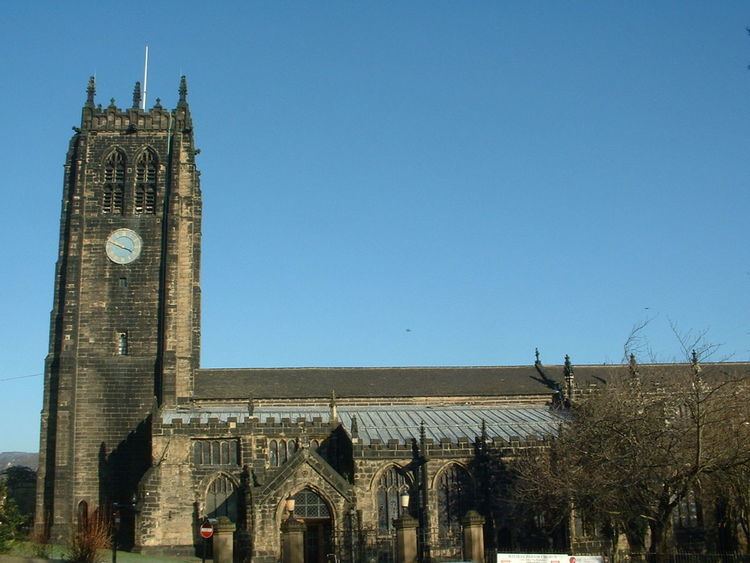Country United Kingdom Churchmanship Broad Church Dedication John the Baptist | Phone +44 1422 355436 Heritage designation Listed building | |
 | ||
Website www.halifaxminster.org.uk Address Causeway, Halifax HX1 1QL, UK Architectural type English Gothic architecture Similar Halifax Town Hall, Shibden Hall, Piece Hall, Leeds Minster, Bankfield Museum Profiles | ||
Halifax minster west yorkshire
Halifax Minster in Halifax, West Yorkshire, England, is dedicated to St John the Baptist; three West Yorkshire minsters are at Dewsbury (1993), Halifax (2009) and Leeds (2012).
Contents
- Halifax minster west yorkshire
- Halifax minster fairest lord jesus
- A brief history
- Features
- Organ
- References
Halifax minster fairest lord jesus
A brief history
There has certainly been a church at Halifax for about 900 years. The Minster, formerly a Parish Church until 23 November 2009, was completed by about 1438. It comprises a nave, chancel and full-length aisles, and is thought to be the third church on this site, but it includes stonework from earlier periods. There are a few carved chevron stones, which date from before 1150, and several 12th century tomb-covers in the porch. Windows of the Early English style in the north wall are replacements of originals dating from the 14th century. A portion of this north wall is much earlier, and may have originally been part of the Norman church; it has sometimes been claimed this was the south wall of an older church.
After the completion of the present nave and chancel, several additions were made. The tower was erected between 1449 and 1482; and the Rokeby and Holdsworth Chapels - originally chantry chapels - were completed by about 1535.
Jacobean box pews are a prominent feature of the Minster, and most of those in the nave date from 1633 to 1635. They bear some similarity to those at Bolton Percy, and the names of the carpenters involved are known. A pew in the centre aisle bears the remains of a memorial brass to John Waterhouse, who died in 1539/40. The carved arms of Richard Sunderland of High Sunderland, who died in 1634, are attached to another pew. Several ancient pew nameplates may be seen attached to a board on the inner north wall of the tower, the oldest dates to 1615 and reads “This stall made at the cost of Robert Fisher of Halifax.”
A small portion of Medieval stained-glass survives in the upper westernmost clerestory window, which was removed from other windows in the mid 19th century. The Puritans who were prominent in the town in the 17th century, thought stained glass with its ‘images’ was an abomination. During the Commonwealth (1649–1660) many plain-glass leaded windows of a unique design were installed, paid for by Mrs Dorothy Waterhouse. Many of these were later replaced by Victorian stained glass, but those that survived in 1958 were carefully rebuilt. At that date there were three of these on each side of the chancel, but now there are five on the south side and only one on the north. The large west window in the tower is a late 19th-century reconstruction of a Commonwealth window dating from 1657, but contains no original work. The great east window of the church depicts the Crucifixion and Resurrection of Jesus, and was completed in 1854. It is the work of George Hedgeland (1825–98), who exhibited stained glass at the Great Exhibition of 1851. The remaining glass in the Parish Church dates also from the Victorian and Edwardian periods.
Features
In 1878 and 1879 a great internal restoration of the church took place, under the leadership of Vicar Francis Pigou (1875–88). This involved the removal of obtrusive galleries, and plaster from the internal walls.
A more recent reordering scheme took place in 1983, when pews at the east end of the nave were removed, and a dais installed for the nave altar. At the Millennium after an Appeal, Victorian pews were removed from the west end of the church, to provide an open and attractive reception area, with adjacent fitted kitchen.
Outside the Minster - have a look at the gargoyles. The one nearest to you to the left of the porch represents the man who played the bagpipes on the gibbet before the condemned man laid down his head for the last time. Also, have a look at the tombstone of John Logan. This is to the right as you leave the south door, at the foot of the wall beneath the westernmost window of the south aisle, and below the sundial. After reading the inscription you may well feel that it should end ... “Respect the soldier’s wives.”
On Saturday the (31 March 2007) the stand of the 1st Battalion, Duke of Wellington's Regiment (West Riding) Regulation colours, taken out of service in 2002, in Osnabrück, Germany, at the Regiments Tercentenary parade, were laid up in the Parish church. The Colour party, with 2 escorts of 40 troops, Had marched through Halifax from the Town hall, preceded by the Regimental Drums and the Heavy Cavalry and Cambrai Band. There was a short ceremony in the Minster grounds where the Troops were inspected by Colin Stout, the then-Mayor of Halifax, and Ingrid Roscoe, Lord Lieutenant of West Yorkshire.
Organ
The church houses an organ, built in 1763 and installed in 1766, built by John Snetzler. The organ has been elarged several times in the 19th and 20th centuries. It was completely rebuilt in 1928 by Harrison & Harrison of Durham. Only a small amount of the Snetzler work remains in the present instrument. Simon Lindley of Leeds Parish Church describes this instrument as “the Rolls Royce of organs.”
A specification of the organ can be found on the National Pipe Organ Register.
